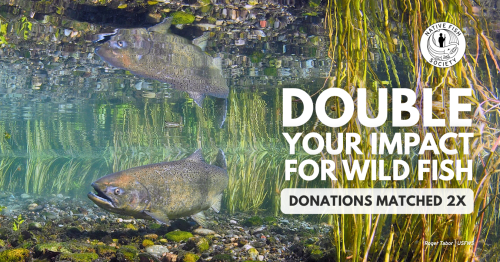StEELhead Discoveries Series - Part 9: May 2024
*This is Part 9 of an ongoing series on the campaign to Free the Eel and efforts to better understand and revive the iconic steelhead in the Pacific Northwest by Native Fish Society Fellow Samantha Kannry. View all parts of the series HERE. Additional parts and updates will be posted over the next several months. Stay tuned!
~ ~ ~ ~ ~ ~
"This spring finds us in the analysis phase of the steelhead life-history project. We completed the lab work and were rewarded with sequencing data from nearly 2600 O. mykiss and 500 coastal cutthroat samples (we already have data from an additional ~550 coastal cutthroat). These O. mykiss tissue samples were collected from 2020-2023 from the Mattole River, North Fork Eel, Mad River, Redwood Creek, Klamath River, Trinity River, Smith River (all northern California), and the Rogue River. All are basins that either once held or are presently home to summer-run steelhead (and winter-run, and some even have fall-run too). In addition to these 2600 samples, we have 800 previously collected from the Middle Fork, Upper Main, and Van Duzen Rivers of the Eel River basin, and we will be doing additional sampling in the Klamath and elsewhere this summer to augment.
Analysis consists of first assigning all the reads from the sequencer (small fragments of genetic code) to their respective individuals. We then have a file for each individual with a subset of its genome. We use that file and our corresponding bit of information about the individual, i.e., when it was sampled, where it was sampled, how big it was, and whether it was found above any barriers, to frame our analyses. We are looking at whether each individual was a summer or winter-run fish and are making maps to display the frequency of the two runs across the landscape. We are using the data to determine the frequencies of the genotypes associated with residency and anadromy at our sampling locations. In addition, we are examining the relatedness between sampling locations and sub-populations, the genetic diversity of individuals, locations, and sub-populations, and, in the near future, the distribution of fall-run steelhead.
These questions are leading us to further characterization of the genetic diversity and geographic distribution of life-histories O. mykiss within our region. The hope is that a deeper understanding of O. mykiss will assist in making informed management and restoration decisions. We want to make people more aware of how unique and rare these populations of native fish are, as is true of the rivers and creeks that give birth to them. Stay tuned for results. And if you happen to live in northwestern California, come join us this Sunday, May 12th, for our Free the Eel flotilla, where we get folks out on the river to let PG&E know the dams need to come out ASAP."
-Samantha Kannry


~~~~~
About the Author:
Samantha Kannry has been monitoring, studying, and swimming with summer-run steelhead in the Eel River and other rivers of Northwestern California for the past thirteen years. She joined NFS as a volunteer in 2015, then became a fish genetics fellow in 2020.
While it has been clear to the native peoples of the region since time immemorial that summer-run steelhead and the congeneric spring Chinook are separate populations, not everyone else sees it so clearly. Her research has focused on using conservation genetic tools to elucidate the distinction between summer and winter-run steelhead.
When not minking (a combination of hiking, swimming, snorkeling, sliding, shimmying, and boulder jumping) down rivers, she is usually growing and eating fruit, moving manure at Caudal Fin Farm, or bike touring distances large and small. All working towards re-establishing the inherent continuity between rivers, land, and people.
Read StEELhead Discoveries Part 1 - 7 HERE.

